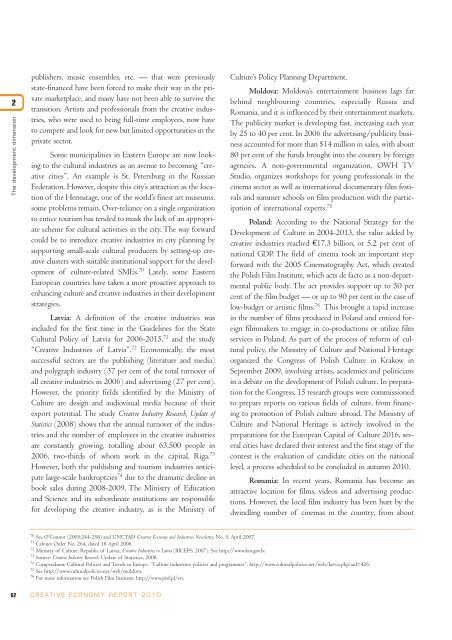Creative Economy: A Feasible Development Option
Creative Economy: A Feasible Development Option
Creative Economy: A Feasible Development Option
- No tags were found...
You also want an ePaper? Increase the reach of your titles
YUMPU automatically turns print PDFs into web optimized ePapers that Google loves.
2The development dimensionpublishers, music ensembles, etc. — that were previouslystate-financed have been forced to make their way in the privatemarketplace, and many have not been able to survive thetransition. Artists and professionals from the creative industries,who were used to being full-time employees, now haveto compete and look for new but limited opportunities in theprivate sector.Some municipalities in Eastern Europe are now lookingto the cultural industries as an avenue to becoming “creativecities”. An example is St. Petersburg in the RussianFederation. However, despite this city’s attraction as the locationof the Hermitage, one of the world’s finest art museums,some problems remain. Over-reliance on a single organizationto entice tourism has tended to mask the lack of an appropriatescheme for cultural activities in the city. The way forwardcould be to introduce creative industries in city planning bysupporting small-scale cultural producers by setting-up creativeclusters with suitable institutional support for the developmentof culture-related SMEs. 70 Lately, some EasternEuropean countries have taken a more proactive approach toenhancing culture and creative industries in their developmentstrategies.Latvia: A definition of the creative industries wasincluded for the first time in the Guidelines for the StateCultural Policy of Latvia for 2006-2015, 71 and the study“<strong>Creative</strong> Industries of Latvia”. 72 Economically, the mostsuccessful sectors are the publishing (literature and media)and polygraph industry (37 per cent of the total turnover ofall creative industries in 2006) and advertising (27 per cent).However, the priority fields identified by the Ministry ofCulture are design and audiovisual media because of theirexport potential. The study <strong>Creative</strong> Industry Research, Update ofStatistics (2008) shows that the annual turnover of the industriesand the number of employees in the creative industriesare constantly growing, totalling about 63,500 people in2006, two-thirds of whom work in the capital, Riga. 73However, both the publishing and tourism industries anticipatelarge-scale bankruptcies 74 due to the dramatic decline inbook sales during 2008-2009. The Ministry of Educationand Science and its subordinate institutions are responsiblefor developing the creative industry, as is the Ministry ofCulture’s Policy Planning Department.Moldova: Moldova’s entertainment business lags farbehind neighbouring countries, especially Russia andRomania, and it is influenced by their entertainment markets.The publicity market is developing fast, increasing each yearby 25 to 40 per cent. In 2006 the advertising/publicity businessaccounted for more than $14 million in sales, with about80 per cent of the funds brought into the country by foreignagencies. A non-governmental organization, OWH TVStudio, organizes workshops for young professionals in thecinema sector as well as international documentary film festivalsand summer schools on film production with the participationof international experts. 75Poland: According to the National Strategy for the<strong>Development</strong> of Culture in 2004-2013, the value added bycreative industries reached €17.3 billion, or 5.2 per cent ofnational GDP. The field of cinema took an important stepforward with the 2005 Cinematography Act, which createdthe Polish Film Institute, which acts de facto as a non-departmentalpublic body. The act provides support up to 50 percent of the film budget — or up to 90 per cent in the case oflow-budget or artistic films. 76 This brought a rapid increasein the number of films produced in Poland and enticed foreignfilmmakers to engage in co-productions or utilize filmservices in Poland. As part of the process of reform of culturalpolicy, the Ministry of Culture and National Heritageorganized the Congress of Polish Culture in Krakow inSeptember 2009, involving artists, academics and politiciansin a debate on the development of Polish culture. In preparationfor the Congress, 15 research groups were commissionedto prepare reports on various fields of culture, from financingto promotion of Polish culture abroad. The Ministry ofCulture and National Heritage is actively involved in thepreparations for the European Capital of Culture 2016, severalcities have declared their interest and the first stage of thecontest is the evaluation of candidate cities on the nationallevel, a process scheduled to be concluded in autumn 2010.Romania: In recent years, Romania has become anattractive location for films, videos and advertising productions.However, the local film industry has been hurt by thedwindling number of cinemas in the country, from about70 See O’Connor (2005:244-258) and UNCTAD <strong>Creative</strong> <strong>Economy</strong> and Industries Newsletter, No. 5, April 2007.71 Cabinet Order No. 264, dated 18 April 2006.72 Ministry of Culture, Republic of Latvia, <strong>Creative</strong> Industries in Latvia (BICEPS, 2007). See http://www.km.gov.lv.73 Source: <strong>Creative</strong> Industry Research. Update of Statistics, 2008.74 Compendium: Cultural Policies and Trends in Europe. “Culture industries: policies and programmes”. http://www.culturalpolicies.net/web/latvia.php?aid=426.75 See http://www.culturalpolicies.net/web/moldova.76 For more information see Polish Film Institute: http://www.pisf.pl/en.62 CREATIVE ECONOMY REPORT 2010
















